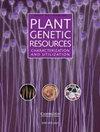鹰嘴豆(Cicer arietinum L.) SSR和形态资料的多变量分析
IF 0.7
4区 生物学
Q3 PLANT SCIENCES
Plant Genetic Resources: Characterization and Utilization
Pub Date : 2023-03-07
DOI:10.1017/s1479262123000059
引用次数: 0
摘要
为了提高阿根廷Córdoba国立大学育种计划和种质资源收集的鹰嘴豆材料的遗传潜力,利用SSR和形态数据进行多变量分析,全面了解鹰嘴豆基因型内和基因型间遗传变异的数量和模式。利用分子数据确定基因型鉴定的判别能力,并寻找最佳引物组合以确保明确鉴定。对53个基因型的15个SSR标记进行分析,共检测到58个等位基因,每个位点的等位基因个体值在1 ~ 9个之间。对于至少四个评估的标记,获得了高辨别能力值(Dj大于或等于0.7,PIC大于或等于0.7)和低混淆概率值(Cj≥0.23)。TA113 + TA114 + H1B09 + TA106引物组合可有效区分53种鹰嘴豆基因型,累积混淆概率值(Ck)为9.60 × 10−4。除个别例外情况外,共识树中一个簇内的鹰嘴豆基因型之间的起源或谱系关系肯定更密切。结果证实,多变量数据分析方法,协调和聚类,是互补的。在大多数基因型中,判别主成分分析分类与分子数据定义的原始聚类一致。分子和形态数据结果的差异表明,它们为建立鹰嘴豆材料间的亲缘关系和更好地描述和解释种质资源中的可利用变异提供了补充和相关的信息。本文章由计算机程序翻译,如有差异,请以英文原文为准。
Multivariate analysis from SSR and morphological data in chickpea (Cicer arietinum L.) for breeding purposes
In order to enhance genetic potential of chickpea materials from the National University of Córdoba Breeding Programme and Germplasm collection (Argentina), a study for a comprehensive understanding of the amount and pattern of genetic variation within and between genotypes was carried out by applying a multivariate analysis form single simple repeats (SSR) and morphological data. Molecular data were also used to determine the discriminating power for genotype identification, and to find the optimal primer combination to ensure unambiguous identification. With the analysis of 15 SSR markers on 53 genotypes, a total of 58 alleles were detected with individual values ranging from one to nine alleles per locus. High values of discriminating power (Dj ⩾ 0.7, PIC ⩾ 0.7), and low values of confusion probability (Cj ⩽ 0.23) were obtained for at least four evaluated markers. The combination of TA113 + TA114 + H1B09 + TA106 primers was effective for discriminating the 53 chickpea genotypes with a cumulative confusion probability value (Ck) of 9.60 × 10−4. Except for some exceptions, individual chickpea genotypes within a cluster in the consensus tree were definitely more closely related with each other by the origin or pedigree. The results confirmed that both multivariate data analysis methods, ordination and clustering, were complementary. In most genotypes, discriminant principal component analysis classification was consistent with the original clusters defined by molecular data. Differences in results from molecular and morphological data indicate that they provide complementary and relevant information for establishing genetic relationships among chickpea materials and a better description and interpretation of the available variability in the germplasm collection.
求助全文
通过发布文献求助,成功后即可免费获取论文全文。
去求助
来源期刊

Plant Genetic Resources: Characterization and Utilization
Agricultural and Biological Sciences-Agronomy and Crop Science
CiteScore
2.80
自引率
0.00%
发文量
29
审稿时长
>12 weeks
期刊介绍:
Plant Genetic Resources is an international journal which provides a forum for describing the application of novel genomic technologies, as well as their integration with established techniques, towards the understanding of the genetic variation captured in both in situ and ex situ collections of crop and non-crop plants; and for the airing of wider issues relevant to plant germplasm conservation and utilisation. We particularly welcome multi-disciplinary approaches that incorporate both a technical and a socio-economic focus. Technical aspects can cover developments in technologies of potential or demonstrated relevance to the analysis of variation and diversity at the phenotypic and genotypic levels.
 求助内容:
求助内容: 应助结果提醒方式:
应助结果提醒方式:


